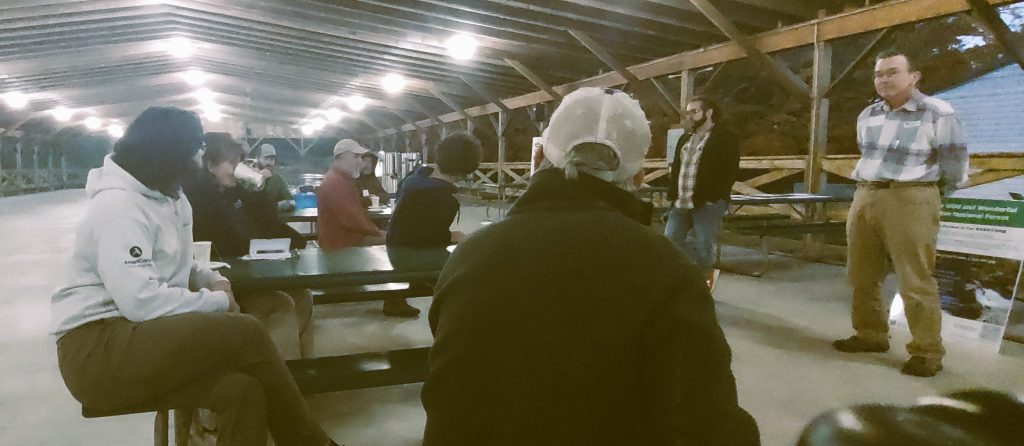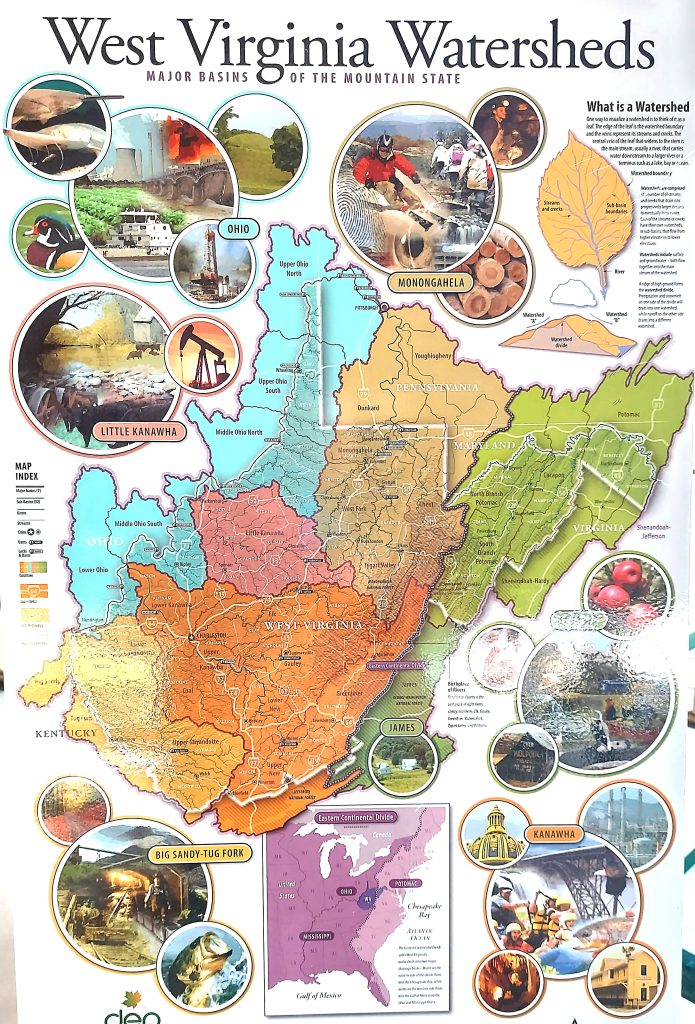

By: Jennifer Britt
The Parsons Advocate
West Virginia Rivers Public Lands Campaign Coordinator, Mike Jones, along with Program Study Director, Jeremy Morris, provided an extremely informative public session, at the Canaan Valley Resort, discussing the issues highlighted in the recent report containing results from 12 listening sessions held in 2021 with recreational users ranging from hikers and bikers to paddlers and anglers. Participants in the listening sessions identified areas of concern and visions for an improved recreational experience in the Mon Forest.
The report identifies a need for trail maintenance and development, addressing over-visitation threats to wilderness, marketing less visited areas, and assuring access for all communities regardless of economic or other status. Jones explained West Virginia Rivers Coalition to the audience members and said, “Part of my job is to help protect public land but also some federal lands like the Mon Forest. For 32 years a state wide advocacy group that researches concerns about waters and rivers. We are committed to serving and restoring West Virginia’s exceptional rivers and streams. We do a lot of work with citizen science, water monitoring and water quality. We have got to expand our reach of scope because water is everywhere in West Virginia.”
Jones continued by saying, “We became interested as an organization in studying what is needed for protection of the Mon Forest. We are very aware of the outstanding job the Forest Service does preserving some of the headwaters. The headwaters are some of the cleanest, purest, best waters in West Virginia come out of the Mon Forest. So, we commissioned Jeremy (Morris) to do a study and listening group.”
The listening group was held by Zoom meetings due to the COVID pandemic and consisted of public opinions from paddlers, mountain bikers, hunters, hikers, backpackers, and those with concerns about handicap access and invading plants species. The listening group also had members from the LBGTQ and Native American communities as well as other minorities.
Morris added, “We brought all those groups on-line and I also did a lot of conservations one-on-one on the different aspects of recreation in the forest. In those sessions we asked very simple questions about recreation in the forest. We asked where do you go on Mon, how do you get there, do you encounter problems finding your way or accessing the recreation you want to participate in, and how they felt the experience could be improved.”
Morris stated the top two concerns from the listening groups were the state or condition of the trails and the need to develop new trails and the preservation of the wilderness in Dolly Sods. Other concerns mentioned were the disparity of the forest mapping, access in underserved communities, involvement of minority groups, more gauges in the streams, public access at state railroad bridges, non-evasive plant species, and funding with a budget decline.
According to the executive summary of the findings and recommendations found at wvrivers.org, “The Monongahela National Forest is the crown jewel of West Virginia’s public lands. Created in 1920 and known as the Mon, it encompasses 1.7 million acres, 921,000 of which are actively managed by the United States Forest Service (USFS). Located in central Appalachia, the Mon is one of the most biologically complex forest systems on the planet. It’s home to at least 75 tree species, more than 225 bird species, 60 nongame/forage fish species, 12 game fish species, and numerous other wildlife species. Additionally, eight federally listed, threatened, or endangered bird, bat, salamander, and plant species call the Mon home.
This yearlong effort by West Virginia Rivers Coalition to listen to the public about outdoor recreation and environmental quality in the Mon enables WV Rivers to be inclusive of and responsive to the diverse array of users in its conservation and public lands policy work.
For nearly two decades, agencies across the federal government have experienced declining budgets, and the USFS has not been immune to these cuts. Throughout the Our Wild and Wonderful Mon Listening Sessions, forest users expressed concerns about the impacts of these cuts on both recreational experiences and environmental quality. Hikers, mountain bikers, anglers, and tourism developers alike voiced concern about the forest service’s ability to creatively manage a 21st-century forest if the operating budget continues to wane.
West Virginia’s waterways are most significantly at risk amidst the declining USFS resources. The Mon Forest is headwaters to many West Virginia Rivers such as the Potomac, Greenbrier, Elk, Tygart, Cheat, and Gauley. These waterways are crucial to local economies and provide drinking water to many residents downstream. In some regards, West Virginia is a water tower for the eastern United States; our waterways provide clean flowing mountain water to 9% of the nation’s population.
Expanding the resources available to the USFS in the region is critical. Widening the financial and human resources available to the Mon Forest Service will take a concerted effort of advocacy by constituents and legislative action by West Virginia’s elected officials, both in Washington, D.C., and Charleston. While the budget and resources of the USFS need to increase, it doesn’t mean the federal footprint of the agency must expand. The Mon Forest encompasses a diverse region of small communities with vibrant non-profit organizations and a strengthening business sector. Empowering these organizations as USFS partners is the creative solution to broadening recreational opportunities and environmental restoration within the boundaries of the forest.
The U.S. Forest Service could serve as the pass-thru of funding to organizations or businesses to operate any number of recreational and visitor services, in addition to necessary habitat restoration projects. Working through public and private partnerships, we can build a 21st century Monongahela National Forest that not only continues its legacy as a Land of Many Uses but also ensures that ongoing legacy is responsive to the changing needs of its residents and users. These types of cooperative partnerships empower local communities to have healthy relationships with the Forest Service. They leverage local and state investment into Mon Forest projects, and these efforts are attractive to private foundations.
Additionally, this type of programmatic effort doesn’t require an expansion of federal employees or property. It ensures that tax dollars are reinvested directly into projects that enhance the community There are many forces placing pressure on the integrity of the Mon Forest and its communities beyond declining budgets. The pandemic has increased visitation to the region, with many people looking for socially distant outdoor experiences.
Likewise, the newly designated national park at the New River Gorge will likely increase visitation to the state in the coming years. Once visitors experience the beauty of the Mon forest, they inevitably return. As the pandemic winds on the economic pressures of various magnitude are deeply affecting families and communities across the Mon region and our nation.
Visitors create tremendous economic value, but also place pressure on facilities and natural habitat. Finding a balance between economic value and environmental sustainability is crucial and requires long-range planning with input from all entities that value the resources of the Mon Forest.
Timing is also critical on a political level, as each election brings new opportunities and challenges. West Virginia is in a unique situation with Senator Manchin serving as chair of the Senate Energy and Natural Resources Committee. WV Rivers can take this opportunity to convey the public’s experiences, concerns, and needs to the Senator, thus painting a broader picture of how public lands and conservation policies under his committee’s jurisdiction impact West Virginia and users of the Mon.
The Mon Forest is the best of West Virginia, truly wild and wonderful. As a state, we should strive to create a forest that provides recreational users with unique experiences they will cherish for a lifetime. We should make the Mon Forest the most data-connected forest in the nation, giving foresters, scientists, and decision-makers cutting-edge tools for their work. Lastly, we should always ensure that this precious land is carefully managed and respected for the next century of West Virginians to enjoy.”
Audience member Gary Berti said, “First, I want to thank you guys for coming out tonight it makes a difference reaching out to everybody. Second, advocacy wise there is no one in West Virginia that is doing the job you guys are doing. Thank you for that.”
Another member of the audience Dylan Jones the owner, editor-in-chief, and publisher of Highland Outdoors magazine added what he felt was a disgrace to the natural beauty of the West Virginia Waterfall Trail. Jones said, “I had some friends that went down to Seneca Creek this past weekend. They said they went down the big main Tucker Falls where is now a West Virginia tourist post with a sign that says take your Instagram shot with the waterfall. There is a QR code and a thing about what to do later if you do not have cell phone service. I find that to be pretty disgusting to be honest because the last thing we need is more signs in front of waterfalls hiding natural features. Also, that is in the National Forest area.
I was just amazed to hear that. I do not like the direction the office of tourism is headed. They are all about Instagram and bringing in more people without considering the impacts for either the people that are in these locations or the impacts bringing in a million or more people to trample the waterfalls and take Instagram pictures.”
Other guest such as Chip Chase and Wyatt Ronelli also voiced their concerns and asked questions of Jones and Morris. Jones stated anyone with concerns or questions can email him at MJones@wvrivers.org and the full report can be found at WVRivers.org/OurMonForest.



